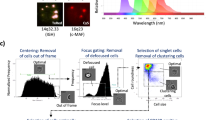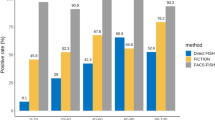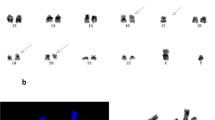Abstract
Many patients with t(8;21) AML have residual positive cells during remission. We previously developed D-FISH probes that detect both derivative chromosomes and the normal alleles. In negative controls, only 2/44000 (0.0045%) positive signals were observed. To investigate MRD, we examined specimens from 29 patients who had initially obtained CR. In remission patients, 61% had 1–4/2000 positive cells (0.05–0.19%). Higher frequencies were found in two patients in early relapse and in one patient in early remission. However, a negative test did not exclude relapse. Since false positives were negligible and because most t(8;21) AMLs express CD34, we asked whether cell sorting combined with FISH would increase the sensitivity. In one patient, we observed that 80% of CD34+ cells were t(8;21)+ at 2 months from initial clinical and cytogenetic remission. However, by 5 months the pre- and post-sorted populations contained 0.15% and 0.06% t(8;21) cells, respectively. Whereas essentially all t(8;21) cells in the initial specimen expressed CD34, only 0.6% were subsequently CD34+. These results are consistent with in vitro assays showing that residual t(8;21) cells undergo differentiation. Thus, FISH can identify MRD in a majority of t(8;21) patients and, combined with CD34+ selection, may provide an indirect assessment of the differentiation state of residual t(8;21) cells.
This is a preview of subscription content, access via your institution
Access options
Subscribe to this journal
Receive 12 print issues and online access
$259.00 per year
only $21.58 per issue
Buy this article
- Purchase on Springer Link
- Instant access to full article PDF
Prices may be subject to local taxes which are calculated during checkout


Similar content being viewed by others
References
Walker H, Smith FJ, Betts DR . Cytogenetics in acute myeloid leukaemia Blood Rev 1994 8: 30–36
Nucifora G, Rowley JD . The AML1 and ETO genes in acute myeloid leukemia with a t(8;21) Leuk Lymphoma 1994 14: 353–362
Erickson P, Gao J, Chang KS, Look T, Whisenant E, Raimondi S, Lasher R, Trujillo J, Rowley J, Drabkin H . Identification of breakpoints in t(8;21) acute myelogenous leukemia and isolation of a fusion transcript, AML1/ETO, with similarity to Drosophila segmentation gene, runt Blood 1992 80: 1825–1831
Miyoshi H, Kozu T, Shimizu K, Enomoto K, Maseki N, Kaneko Y, Kamada N, Ohki M . The t(8;21) translocation in acute myeloid leukemia results in production of an AML1-MTG8 fusion transcript EMBO J 1993 12: 2715–2721
Chang KS, Fan YH, Stass SA, Estey EH, Wang G, Trujillo JM, Erickson P, Drabkin H . Expression of AML1-ETO fusion transcripts and detection of minimal residual disease in t(8;21)-positive acute myeloid leukemia Oncogene 1993 8: 983–988
Downing JR, Head DR, Curcio-Brint AM, Hulshof MG, Motroni TA, Raimondi SC, Carroll AJ, Drabkin HA, Willman C, Theil KS et al. An AML1/ETO fusion transcript is consistently detected by RNA-based polymerase chain reaction in acute myelogenous leukemia containing the (8;21)(q22;q22) translocation Blood 1993 81: 2860–2865
Nucifora G, Larson RA, Rowley JD . Persistence of the 8;21 translocation in patients with acute myeloid leukemia type M2 in long-term remission Blood 1993 82: 712–715
Miyamoto T, Weissman IL, Akashi K . AML1/ETO-expressing nonleukemic stem cells in acute myelogenous leukemia with 8;21 chromosomal translocation Proc Natl Acad Sci USA 2000 97: 7521–7526
Tobal K, Liu Yin JA . Molecular monitoring of minimal residual disease in acute myeloblastic leukemia with t(8;21) by RT-PCR Leuk Lymphoma 1998 31: 115–120
Miyamoto T, Nagafuji K, Harada M, Niho Y . Significance of quantitative analysis of AML1/ETO transcripts in peripheral blood stem cells from t(8;21) acute myelogenous leukemia Leuk Lymphoma 1997 25: 69–75
Marcucci G, Livak KJ, Bi W, Strout MP, Bloomfield CD, Caligiuri MA . Detection of minimal residual disease in patients with AML1/ETO-associated acute myeloid leukemia using a novel quantitative reverse transcription polymerase chain reaction assay Leukemia 1998 12: 1482–1489
Tobal K, Newton J, Macheta M, Chang J, Morgenstern G, Evans PA, Morgan G, Lucas GS, Liu Yin JA . Molecular quantitation of minimal residual disease in acute myeloid leukemia with t(8;21) can identify patients in durable remission and predict clinical relapse Blood 2000 95: 815–819
el-Rifai W, Ruutu T, Vettenranta K, Temtamy S, Knuutila S . Minimal residual disease after allogeneic bone marrow transplantation for chronic myeloid leukaemia: a metaphase-FISH study Br J Haematol 1996 92: 365–369
Varella-Garcia M . Assessing residual leukemia through fluorescence in situ hybridization (FISH) Gen Mol Biol 1998 21: 323–327
Paskulin GA, Philips G, Morgan R, Sandberg A, Richkind K, Borovik C, McGavran L, Rabinovich N, Dietz-Band J, Erickson P, Drabkin H, Varella-Garcia M . Pre-clinical evaluation of probes to detect t(8;21) AML minimal residual disease by fluorescence in situ hybridization Genes Chromosomes Cancer 1998 21: 144–151
Fischer K, Scholl C, Salat J, Frohling S, Schlenk R, Bentz M, Stilgenbauer S, Lichter P, Dohner H . Design and validation of DNA probe sets for a comprehensive interphase cytogenetic analysis of acute myeloid leukemia Blood 1996 88: 3962–3971
Dewald GW, Wyatt WA, Juneau AL, Carlson RO, Zinsmeister AR, Jalal SM, Spurbeck JL, Silver RT . Highly sensitive fluorescence in situ hybridization method to detect double BCR/ABL fusion and monitor response to therapy in chronic myeloid leukemia Blood 1998 91: 3357–3365
Andrieu V, Radford-Weiss I, Troussard X, Chane C, Valensi F, Guesnu M, Haddad E, Viguier F, Dreyfus F, Varet B, Flandrin G, Macintyre E . Molecular detection of t(8;21)/AML1-ETO in AML M1/M2: correlation with cytogenetics, morphology and immunophenotype Br J Haematol 1996 92: 855–865
Kita K, Shirakawa S, Kamada N . Cellular characteristics of acute myeloblastic leukemia associated with t(8;21)(q22;q22). The Japanese Cooperative Group of Leukemia/Lymphoma Leuk Lymphoma 1994 13: 229–234
Tobal K, Liu Yin JA . RT-PCR method with increased sensitivity shows persistence of PML-RARA fusion transcripts in patients in long-term remission of APL Leukemia 1998 12: 1349–1354
Shimizu K, Kitabayashi I, Kamada N, Abe T, Maseki N, Suzukawa K, Ohki M . AML1-MTG8 leukemic protein induces the expression of granulocyte colony-stimulating factor (G-CSF) receptor through the up-regulation of CCAAT/enhancer binding protein epsilon Blood 2000 96: 288–296
Rhoades KL, Hetherington CJ, Harakawa N, Yergeau DA, Zhou L, Liu LQ, Little MT, Tenen DG, Zhang DE . Analysis of the role of AML1-ETO in leukemogenesis, using an inducible transgenic mouse model Blood 2000 96: 2108–2015
Cai Z, de Bruijn M, Ma X, Dortland B, Luteijn T, Downing JR, Dzierzak E . Haploinsufficiency of AML1 affects the temporal and spatial generation of hematopoietic stem cells in the mouse embryo Immunity 2000 13: 423–431
Bonnet D, Dick JE . Human acute myeloid leukemia is organized as a hierarchy that originates from a primitive hematopoietic cell Nat Med 1997 3: 730–737
Lapidot T, Sirard C, Vormoor J, Murdoch B, Hoang T, Caceres-Cortes J, Minden M, Paterson B, Caligiuri MA, Dick JE . A cell initiating human acute myeloid leukaemia after transplantation into SCID mice Nature 1994 367: 645–648
Acknowledgements
We wish to acknowledge the assistance of the Flow Cytometry and Cytogenetics Cores of the University of Colorado Cancer Center. M Andreeff was supported by NIH PO1 CA 55164.
Author information
Authors and Affiliations
Rights and permissions
About this article
Cite this article
Varella-Garcia, M., Hogan, C., Odom, L. et al. Minimal residual disease (MRD) in remission t(8;21) AML and in vivo differentiation detected by FISH and CD34+ cell sorting. Leukemia 15, 1408–1414 (2001). https://doi.org/10.1038/sj.leu.2402219
Received:
Accepted:
Published:
Issue Date:
DOI: https://doi.org/10.1038/sj.leu.2402219



